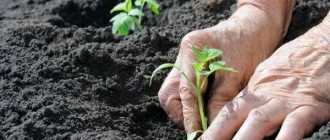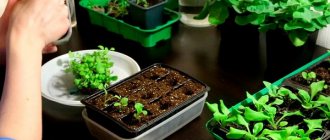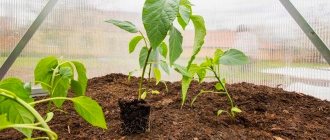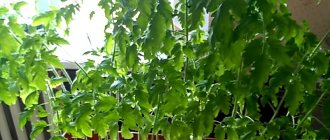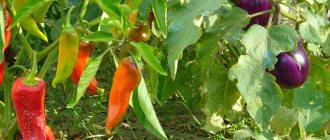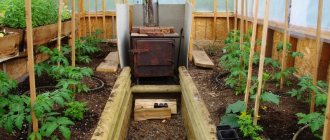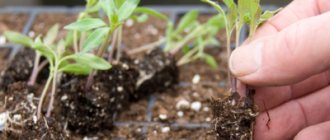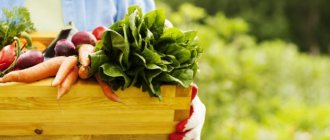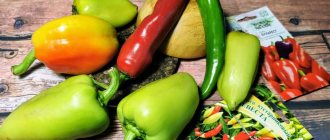It is believed that picking is a simple transplantation of small sprouts into another large container or to a permanent place. But if we go deeper into the question, then picking is also the transplantation of seedlings from a common container into separate cups or pots in order to avoid competition between seedlings for better living conditions. In the article we will figure out whether this crop needs replanting and how to pick peppers at home.
Pros and cons of picking 2. Features of picking pepper 3. Timing of work 3.1. Lunar calendar 4. Preparation 4.1. Containers 4.2. Earth 5. How to pick pepper correctly 6. Care 6.1. Watering 6.2. Top dressing 6.3. Temperature conditions 6.4. Transplantation into the ground
Photo: There are many advantages to moving peppers into separate containers.
Pepper - picking seedlings advantages and disadvantages
Diving has a number of advantages:
- Transplanting a young plant into separate pots will prevent the root system from intertwining, which will improve its development and facilitate subsequent planting in a permanent place of growth.
- The required amount of nutrients in the soil and good lighting will ensure the development of a powerful root system and the above-ground part of the seedlings, resistant to strong gusts of wind.
- Weak, poorly developed specimens are rejected.
- Thanks to this procedure, productivity increases significantly.
- The risk of developing fungal diseases is minimized.
The disadvantage of this procedure is:
- The complexity of the process.
- Risk of damage to the still immature root system.
- Slowing plant growth.
When should you pick pepper?
Seedlings can be planted at the following times:
- After the opening of the germinal (cotyledon) leaves.
- When two or three true leaves appear.
- If there are five or six sheets.
Experienced gardeners rarely pick at the cotyledon leaf stage. During this period, the plant has only a central root, which, if damaged, dies and the plant dies.
The most acceptable period for replanting is considered to be 16-21 days after germination of the seedlings if the seedling has two to three true leaves. At this point, the root system becomes stronger and the plant adapts more easily to the new soil.
At the stage of 5-6 leaves, the root system of plants begins to grow laterally, which will entail intertwining of the roots, and accordingly increasing the risk of damage.
Picking dates according to the lunar calendar
Experienced farmers recommend that when performing this procedure, you should focus on the dates indicated in the lunar calendar. The most favorable period is considered to be the phase of the waxing Moon in the constellation:
- Calf;
- Scales;
- Scorpion.
Unfavorable phases are the new moon and the full moon. The Moon during this period is in the constellations:
- Fish;
- Sagittarius;
- Aries;
- Twins;
- Virgo.
| Month | Favorable days | Unfavorable days |
| March | 2; 3; 7; 10; 12; 16; 17 | 1; 4; 5;18; 21; 23; 24; 25; 26; 28; 29; 30 |
| April | 2; 6; 7; 9; 11 | 5 |
conclusions
- Confirmed by experts - picking pepper seedlings provides them with good conditions for growing.
- The container for planting seedlings must be large, light-proof, and well-drained.
- A delay in plant development up to 14 days after picking is considered normal.
- The optimal time for the procedure of planting pepper sprouts is 20-25 days from the emergence of seedlings.
- The transplanted plant should not be deeply buried.
This link will tell you about soaking pepper seeds before planting.
What is required for picking
To carry out this agrotechnical procedure, you need to prepare the soil mixture and containers with a volume of 200-250 ml in advance. for transplanting seedlings, treated for disinfection with a 1% solution of potassium permanganate.
To prepare the soil, you need to mix the ingredients in the following ratio:
- garden soil—2 parts;
- humus—2 parts;
- peat—2 parts;
- coarse river sand—1 part.
Pepper does not like acidic soil, so to normalize the acidity of the soil, it is recommended to add 250 grams of wood ash per 10 liters to the prepared soil mixture. It is recommended to soak the substrate for 20 minutes in a microwave oven or pour it with a strong solution of hot potassium permanganate to disinfect and destroy pest larvae.
To transplant seedlings, you can use peat pots or plastic glasses with holes to remove excess moisture from the soil. If the cups are transparent, you need to wrap them in a thin layer of paper or newspaper to prevent light from reaching the roots.
Preparing for transplant
Before planting peppers for seedlings, you need to take care of preparing the correct soil mixture and the required number of containers for replanting.
soil mixture
To transplant peppers at home, it is recommended to use high-quality specialized soil intended for nightshade crops. However, some vegetable growers practice preparing their own soil mixture. In this case, it is necessary to take into account some requirements for the substrate, which must be:
- loose, air- and water-permeable;
- rich in nutrients;
- with neutral pH or slightly acidic;
- disinfected from harmful microorganisms and pest larvae.
There are many recipes for preparing soil yourself at home.
First way:
- garden or garden soil - 3 parts;
- lowland peat - 2 parts;
- vermicompost - 3 parts;
- river sand - 1 part;
- perlite or vermiculite - 1 part.
All ingredients are thoroughly mixed.
The resulting substrate must be shed with a 1% solution of potassium permanganate and Fitosporin. Second way:
- turf land - 1 part;
- humus - 3 parts;
- river sand - ½ part.
For a bucket of prepared mixture you will need a glass of ash and 1 tbsp. l of complex mineral fertilizer containing nitrogen, phosphorus, potassium and microelements. Humus should only be used that is well rotted and at least 3 years old. The substrate is frozen or etched with disinfecting solutions.
Third way:
- garden soil - 2 parts;
- vermiculite - 1 part;
- peat - 1 part.
To increase the nutritional value of the substrate, you can add liquid biofertilizer based on humic acids.
The soil, regardless of its composition, is prepared 10-14 days before transplanting the seedlings. The soil ready for picking should not be too dry, but slightly moist.
Capacities
Peppers can be transplanted into 200 or 500 ml cups, peat pots, diapers or boxes.
It is necessary to plant the seedlings into a larger common container according to a pattern of 8 by 8 cm. This distance will be sufficient for the growing seedlings to receive a sufficient amount of light, nutrients and be able to fully develop.
How to pick peppers correctly: step-by-step instructions
In order for the seedlings to successfully take root after picking and not to stop growing, you must adhere to the following recommendations:
- Three hours before transplanting, the seedlings are well watered. Moistened soil will help reduce the risk of damage to the fragile root system.
- The prepared containers are filled with soil to 2/3 of the volume, compacted, a depression is made in it and the soil is moistened.
- Carefully, using a special device or a teaspoon, remove the seedling and separate it from the rest, holding it by the leaves. If several specimens are separated at once, then the strongest and most well-developed ones are planted first. Remove the plant with a small amount of soil so as not to damage the still weak root.
- There is no need to pinch the main root.
- Move the plant into a previously prepared container, making sure that the roots are located freely in the recess and do not intertwine or curl counterclockwise. If the roots are not positioned correctly, seedling growth stops.
- The root is immersed in the soil a little deeper than its previous depth, then carefully lifted so that the earth crumbles under the roots. Excessive deepening should be avoided, as this will slow down development and can lead to rotting of the root system. However, if excessive elongation of the seedlings was observed during the growth process, then when picking it is recommended to deepen it by 1 cm.
- Containers with seedlings are placed on a pallet, soil is added, and lightly compacted around the seedling, squeezing on all sides.
- After replanting, moderate watering should be done with warm, settled water.
- 30 minutes after watering, excess moisture is removed from the pan.
- The containers with the plants are placed in their original place, shaded from sunlight, and left for two to three days to adapt. It is not recommended to move picked seedlings to another place, since a change in microclimate will increase the adaptation period.
- Three days after transplantation, it is necessary to organize additional lighting. Daylight hours should be 8 hours.
What types of procedures are there?
There are several ways to pick peppers.
Traditional method
With the traditional method of carrying out the procedure, you simply need to transplant the peppers from a common container into separate containers. At the same time, it is very important to try not to damage the root, since pepper does not tolerate this.
With the traditional method, it is very important to choose the correct size of the new container so that the pepper does not become crowded again after a while.
Using film
This method (also called Diapering) will save space. It is also good because you can add soil to the resulting “diaper” as the pepper grows.
To pick with film, you will need an empty container and plastic bags.
- Place a tablespoon of soil in the middle of the bag.
- We place the seedling on top so that its roots are in the ground and the rest is outside the diaper.
- Place another spoonful of soil on top of the seedling.
- Roll up the package like a roll.
- We fix it with an elastic band, put it in a container and water it with a syringe.
Method - snail
For this method you will need a roll of isolon about 20 cm wide.
- Unwind the roll.
- Pour about 4 cm of soil on top.
- Carefully twist the snail and secure it with an elastic band.
- We plant the seedlings in a checkerboard pattern so that they do not interfere with each other.
REFERENCE. The disadvantage of this method is that sooner or later you will have to replant again, since there will not be enough space for the peppers.
Transshipment
The essence of this method is that the pepper is picked together with the lump of earth in which it grows. This is done so as not to injure the roots.
Caring for seedlings after picking
After diving, the seedlings require the following care:
- Mandatory temperature control. The temperature in the room should not be lower than +21°C during the day, and +16°C at night. After three days, the temperature is increased to +24°C during the day and +18°C at night.
- Watering should be moderate. It is carried out no more than twice a week, as the top layer of soil dries. Water for irrigation is used warm, standing for 24 hours. If there is insufficient air humidity in the room, it is recommended to carry out irrigation.
- Loosening is carried out after each watering in order to prevent stagnation of moisture in the soil and the formation of a crust on the soil surface, which prevents the saturation of the root system with oxygen.
- Plant feeding is carried out 15 days after the dive. For these purposes you can use:
- yeast feeding (dilute 100 grams of yeast in 10 liters of water);
- nettle decoction (pour 100 grams of nettle with 1 liter of boiling water, leave, strain);
- ash solution (dissolve 20 grams of ash in 1 liter of water, leave for 12 hours);
- complex mineral fertilizers (superphosphate—8 grams, potassium salt—3 grams, urea—1 gram, water—2 liters);
- rotted manure.
After two weeks, fertilizing can be repeated. Avoid nitrogen-containing fertilizers to prevent excessive stretching of seedlings.
- Two weeks before planting seedlings in a permanent place of growth, it is necessary to harden them. When warm weather sets in, it is recommended to take the trays with seedlings out into the fresh air and leave them for a short time in places protected from direct sunlight and gusts of cold wind. The residence time is gradually increased.
Possible problems after picking and ways to solve them
It’s not uncommon for gardeners to encounter the following problems after picking:
- The growth of seedlings has slowed or stopped. This occurs due to damage to the roots. The plant will recover when new roots grow. Another reason for growth failure may be poorly compacted soil after transplantation, when an air space has formed between the soil and the roots of the plants. The roots begin to dry out. The problem can be eliminated by carefully compacting the soil around the seedling.
- Drooping, limp leaves. This problem occurs when the root system is damaged. Torn roots do not absorb moisture. After new roots grow, turgor will be restored.
- The pale color of the leaves indicates insufficient lighting. It is necessary to organize additional lighting using fluorescent lamps.
- The trunk became thinner and changed color. These symptoms indicate the occurrence of a fungal disease in the plant - black leg. The cause of the disease is excessive soil moisture. It is recommended to transplant the seedling into new soil. It is recommended to regularly ventilate the room in which the seedlings grow.
Frequent disputes arise between farmers regarding the need for picking. However, it must be taken into account that this procedure, if performed correctly, will have a beneficial effect on the growth of seedlings and will delight you with a generous harvest.
We are waiting for the opinion of our readers on the issue of picking seedlings.
